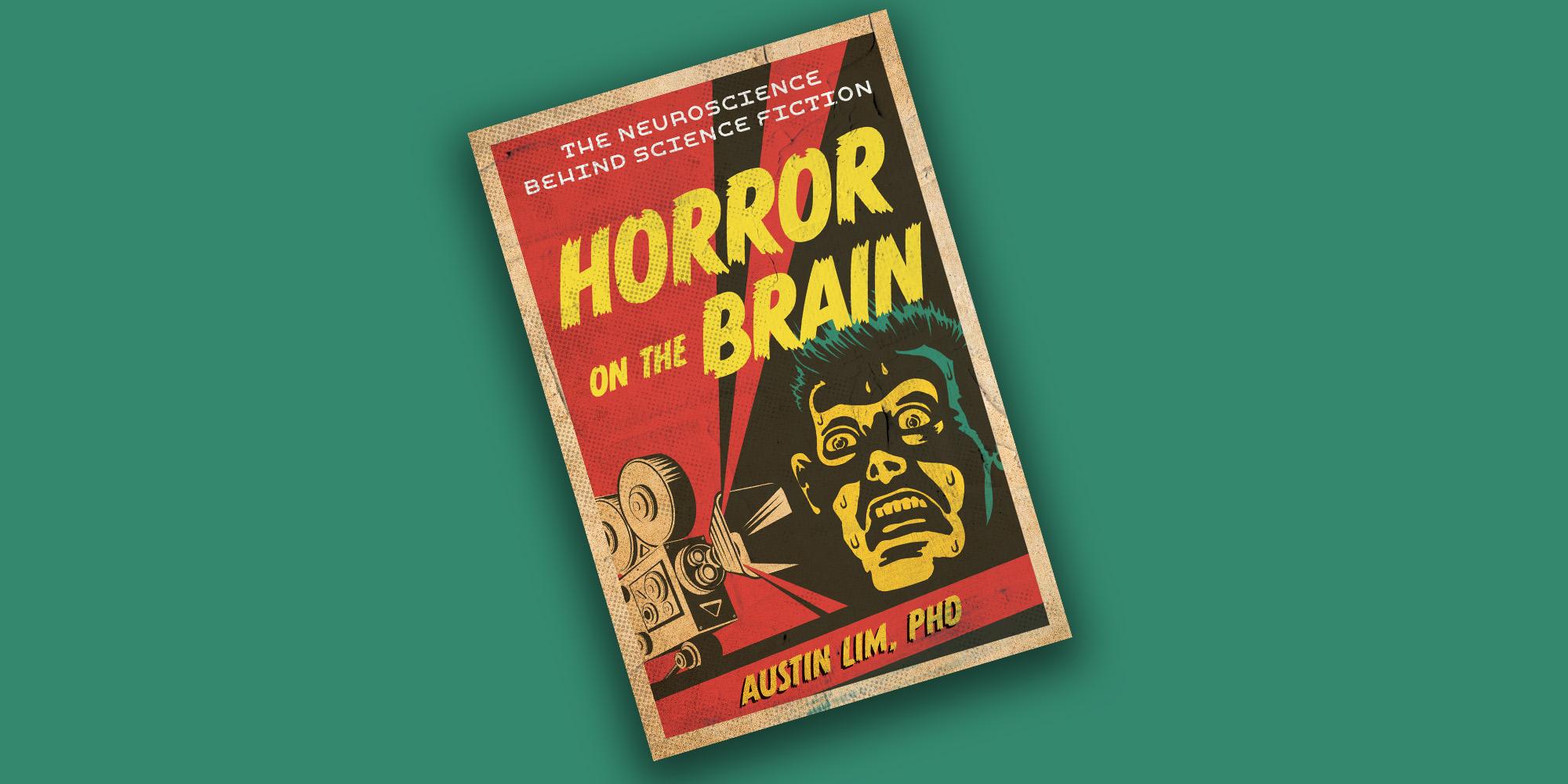In a new book Austin Lim, PhD’14, explores brain science through science fiction.
The unknown is at the heart of both scientific curiosity and horror, Austin Lim, PhD’14, observes in the introduction to his new book. It’s what drove Luigi Galvani to undertake his experiments on the electric stimulation of dead tissue—the experiments that in turn inspired Mary Shelley’s writing of Frankenstein. And it’s why things we can’t explain make us afraid, like the empty hallways and disorienting layout of the Overlook Hotel in The Shining. Horror on the Brain: The Neuroscience Behind Science Fiction (Prometheus Books, 2025) is an exploration of the theory and history of neuroscience through works of horror and science fiction.
Lim delves into the real science that inspired these works, and along the way finds that the books and films themselves offer insights into the complex workings of our brains. For Lim, the science itself may be even scarier than the fiction. There’s a “haunting realization at the end of neuroscience,” he writes, “that we are not even in control over our own bodies and that our fears, desires, emotions, consciousness, and everything else in the multifaceted human experience are guided by clumps of cells.”
Wend your way through three of the science-and-fiction connections Lim explores in Horror on the Brain.
Fear factors
When the governess sees her predecessor’s ghost in the schoolroom in Henry James’s The Turn of the Screw, she first shrieks but then reasons with herself, deciding to she needs to stay and protect the children in her charge. This encounter encapsulates a fear response formally theorized in the 1990s, writes Lim. In this framework, fear operates “at two levels, the physiological and the cognitive,” called the “low road” and the “high road,” respectively.
The low road involves involuntary physiological changes that occur when the sympathetic nervous system, cued by the hypothalamus, increases the concentration of the hormone norepinephrine in our bloodstream to prepare us for action. Our heart rate and breathing quicken, digestive processes slow, pupils dilate, and we may get goosebumps. Like James’s governess, we might even scream. (The hypothalamus also controls hunger and sex drive. “As the joke goes,” Lim writes, “there are four Fs of the hypothalamus: fight, flight, feed, and reproduction.”)
Then a more rational reaction kicks in. This part of the fear response is theorized to originate in the prefrontal cortex, “the fanciest part of our brain,” used in planning and choice: “Circuits here help us inhibit our base animal impulses,” writes Lim. “Thinking that dead people don’t materialize out of thin air or that it is now your duty to protect the innocent children placed at your charge: high road.”
Face to face
At the climax of M. R. James’s 1904 ghost story “Oh, Whistle, and I’ll Come to You, My Lad” the frightened protagonist, Parkins, perceives the features of “a horrible, an intensely horrible” human face in a crumpled linen sheet. The illusion can be explained by pareidolia, “the natural propensity to interpret vague stimuli as something else more easily contextualized,” as Lim defines it. We tend to spot facial features, especially, where they aren’t: A truck’s headlights and grille or the windows and door at the front of a house—if they’re positioned just right—make us think of eyes and a mouth. One theory is that we err on the side of recognizing faces because our protohuman ancestors, hairy as they were, needed to quickly recognize facial features to determine whether they were dealing with a friend or a stranger. This may lead to false positives, but better safe than sorry.
Facial recognition occurs in the bottom of the temporal lobe, near the base of the brain. Researchers have isolated a portion of this region, called the fusiform face area, that is most active in this kind of cognition. Injury to this area can lead to prosopagnosia, an inability to recognize others’ faces. “In a way, prosopagnosia is the conceptual opposite of facial pareidolia: not enough faces or too many faces,” says Lim.
Total recall
William Gibson’s 1981 cyberpunk short story “Johnny Mnemonic” revolves around a courier who stores hundreds of megabytes of clients’ sensitive information in microchips implanted in his head, accessible only to the client with a password. The technology used in the story roughly parallels the actual working of human memory. One common way neuroscientists understand memory, Lim explains, is as a three-step process: Sensory signals are encoded, stored, and recalled.
Short of implanting microchips in your brain, there are ways to improve memory during these steps—some conscious and some biological. Mnemonic devices can help the encoding process. In the memory palace technique used by the ancient Greeks, for example, you enhance the encoding process by imagining walking through a familiar physical space and locating different sensory signals within the space. However, Lim cautions, unlike Johnny, most of us cannot encode everything we experience.
After stimuli are encoded, cell patterns are modified so the stimuli can be stored and eventually recalled. One way the brain improves its ability to store and recall information is through long-term potentiation, the best-studied form of synaptic strengthening: As a signal travels to the brain, the neurotransmitter glutamate is released, starting a process that results in more receptors being available for neurotransmitter binding, so that next time the same input will cause a stronger response.
Maybe Johnny experienced some long-term potentiation between the short story’s publication in 1981 and the 1995 film adaptation starring Keanu Reeves. The filmmakers dramatically increased Johnny’s memory storage from the original hundreds of megabytes to respond to technological developments. “How much am I carrying? 320 gigabytes,” says Reeves’s character. If the movie were remade today, Lim muses, “the data courier might brag about the hundreds of terabytes of valuable corporate data stored somewhere in his head.”
